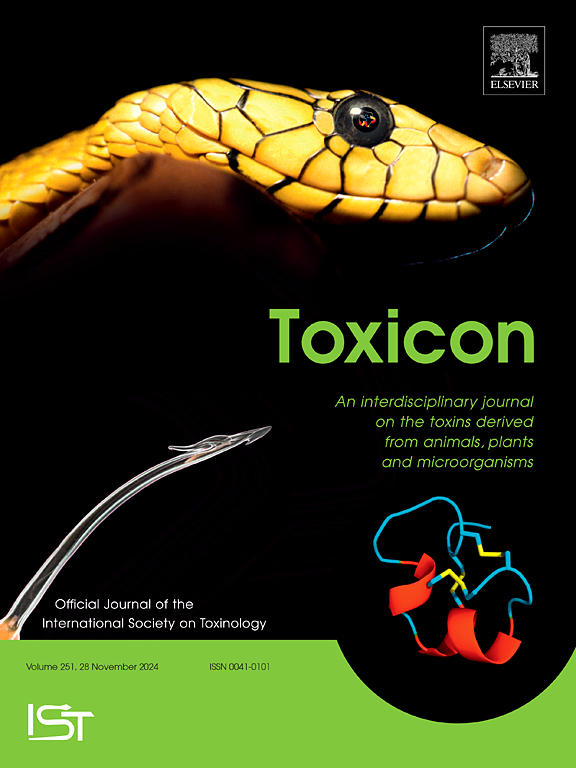黄颡鱼对反刍动物生殖的毒性作用及其毒理学机制综述
IF 2.6
4区 医学
Q2 PHARMACOLOGY & PHARMACY
引用次数: 0
摘要
Leucaena Leucaena Leucaena Leucaena Leucaena Leucaena Leucaena Leucaena Leucaena是一种优质的蛋白质饲料,可以改善热带国家反刍家畜的营养。然而,这种豆科植物的所有部分都含有有毒的次级化合物(含羞草胺和二羟基吡啶)。多项研究表明,藻青属次级化合物会损害雄性和雌性动物的生殖性能,包括性欲和精液质量下降、胚胎和胎儿死亡、畸形和受孕率降低。本文确定了一些可能导致反刍动物繁殖失败的毒理学机制。在此基础上,提出了一些策略,以提高饲养反刍动物的安全性。这些策略可分为通过解毒途径降低氨基糖胺和DHP毒性的策略,以及抵消某些毒性影响的策略,从而间接减少对生殖功能的影响。本文章由计算机程序翻译,如有差异,请以英文原文为准。

The effects and toxicological mechanisms of leucaena toxicity on ruminant reproduction: a review
Leucaena leucocephala (leucaena) is a high-quality proteinaceous feed which can improve the nutrition of ruminant livestock in tropical countries. However, this legume contains toxic secondary compounds (mimosine and dihydroxypyridine) in all parts of the plant. Several studies have shown that leucaena secondary compounds could damage male and female animals' reproductive performance, including decreased libido and semen quality, embryonic and foetal death, malformation, and lower the conception rate. This paper identifies some toxicological mechanisms that might be responsible for reproductive failure in the ruminant. Some strategies are suggested to make leucaena feeding safer for breeding ruminants. These can be categorised into strategies that reduce the toxicity of mimosine and DHP via detoxification pathways, and strategies that counteract certain effects of toxicity, and so indirectly reduce the impact on reproductive function.
求助全文
通过发布文献求助,成功后即可免费获取论文全文。
去求助
来源期刊

Toxicon
医学-毒理学
CiteScore
4.80
自引率
10.70%
发文量
358
审稿时长
68 days
期刊介绍:
Toxicon has an open access mirror Toxicon: X, sharing the same aims and scope, editorial team, submission system and rigorous peer review. An introductory offer Toxicon: X - full waiver of the Open Access fee.
Toxicon''s "aims and scope" are to publish:
-articles containing the results of original research on problems related to toxins derived from animals, plants and microorganisms
-papers on novel findings related to the chemical, pharmacological, toxicological, and immunological properties of natural toxins
-molecular biological studies of toxins and other genes from poisonous and venomous organisms that advance understanding of the role or function of toxins
-clinical observations on poisoning and envenoming where a new therapeutic principle has been proposed or a decidedly superior clinical result has been obtained.
-material on the use of toxins as tools in studying biological processes and material on subjects related to venom and antivenom problems.
-articles on the translational application of toxins, for example as drugs and insecticides
-epidemiological studies on envenoming or poisoning, so long as they highlight a previously unrecognised medical problem or provide insight into the prevention or medical treatment of envenoming or poisoning. Retrospective surveys of hospital records, especially those lacking species identification, will not be considered for publication. Properly designed prospective community-based surveys are strongly encouraged.
-articles describing well-known activities of venoms, such as antibacterial, anticancer, and analgesic activities of arachnid venoms, without any attempt to define the mechanism of action or purify the active component, will not be considered for publication in Toxicon.
-review articles on problems related to toxinology.
To encourage the exchange of ideas, sections of the journal may be devoted to Short Communications, Letters to the Editor and activities of the affiliated societies.
 求助内容:
求助内容: 应助结果提醒方式:
应助结果提醒方式:


